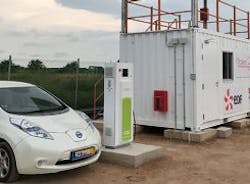New Hampshire Electric Cooperative to use Nuvve Holding’s EV to Grid technology
Vehicle-to-grid (V2G) technology firm Nuvve Holding signed an agreement with the member-owned, not-for-profit New Hampshire Electric Cooperative (NHEC) to provide storage capabilities to the utility at a fixed annual fee.
Its V2G technology will facilitate the use of EV batteries as distributed energy resources to deliver added capacity to the grid and integrate renewables. It will help utilities manage the shifts in energy requirement. It can lower the bills for ratepayers.
Nuvve CEO and Chairman Gregory Poilasne said that V2G technology has immense potential impact on utilities like NHEC.
Brian Callnan, the NHEC's vice president of power resources and access, agreed and explained, “Helping to electrify our members' transportation needs with a more efficient and cleaner technology while providing much-needed services to our distribution grid is a win-win for all our members.”
V2G has received a lot of attention in the recent months. The U.S. Senate is considering funding in the $1.2 trillion Infrastructure and Jobs Act and Build Back Better Framework. Lawmakers are aware of the need to invest in technology, which can help reduce stress on the grid caused by additional demand from EVs. Meanwhile, utilities have started to realize the benefits of V2G for stakeholders and communities.
About the Author
EnergyTech Staff
Rod Walton is senior editor for EnergyTech.com. He has spent 17 years covering the energy industry as a newspaper and trade journalist.
Walton formerly was energy writer and business editor at the Tulsa World. Later, he spent six years covering the electricity power sector for Pennwell and Clarion Events. He joined Endeavor and EnergyTech in November 2021.
He can be reached at [email protected].
EnergyTech is focused on the mission critical and large-scale energy users and their sustainability and resiliency goals. These include the commercial and industrial sectors, as well as the military, universities, data centers and microgrids.
Many large-scale energy users such as Fortune 500 companies, and mission-critical users such as military bases, universities, healthcare facilities, public safety and data centers, shifting their energy priorities to reach net-zero carbon goals within the coming decades. These include plans for renewable energy power purchase agreements, but also on-site resiliency projects such as microgrids, combined heat and power, rooftop solar, energy storage, digitalization and building efficiency upgrades.
